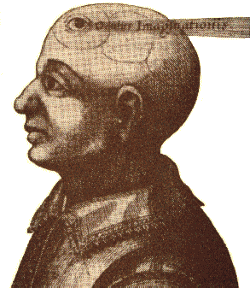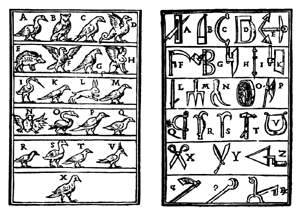The Art of Memory
 The Art of Memory, was said to have
been invented by a poet named Simonides (according to Cicero). In a bit of
ancient forensics, Simonides had been able to identify the remains of guests at
a banquet by their seating places around a table, after a roof had fallen in
upon them and obliterated them beyond recognition. In the Classical use of the
art, abstract images of a somewhat bizarre (and therefore memorable) nature
were conceived that would be linked to parts of a speech and then to a
well-known architectural feature of the hall in which the speech was to take
place. By scanning the variety of statuary, friezes, articulated columns, or
whatever, within the hall, the rhetorician skilled in the art could remember
all the aspects of his speech. The hall would provide the order and a frame of
reference which could be used over and over again for a complex constellation
of constantly changing ideas.
The Art of Memory, was said to have
been invented by a poet named Simonides (according to Cicero). In a bit of
ancient forensics, Simonides had been able to identify the remains of guests at
a banquet by their seating places around a table, after a roof had fallen in
upon them and obliterated them beyond recognition. In the Classical use of the
art, abstract images of a somewhat bizarre (and therefore memorable) nature
were conceived that would be linked to parts of a speech and then to a
well-known architectural feature of the hall in which the speech was to take
place. By scanning the variety of statuary, friezes, articulated columns, or
whatever, within the hall, the rhetorician skilled in the art could remember
all the aspects of his speech. The hall would provide the order and a frame of
reference which could be used over and over again for a complex constellation
of constantly changing ideas.
The Classical art of memory evolved in
the Middle Ages into an Aristotelian form, in which the construction of a
memory image could heighten human perception and therefore aid in the
acceptance of a moral lesson which was being communicated. The Middle Ages had
somewhat limited possibilities to support a refinement of ideas and
observations which sustained the culture. However, with the discovery of the
New World and the rediscovery of the Classical World, a sense of wonder was
brought back into European thought. Exposure to new cultures and possibilities
that existed outside the realm of understanding for Europeans, opened them up
to the idea of exploring (as well as subjugating) the world outside of their
known universe.
 The near simultaneous invention
of movable type, and mass printing, produced another technological refinement
in the collective knowledge of the then 'known world.' Likewise, the skills of
the rhetorician reached their developmental zenith which would then subside as
printed knowledge became more available. Curiously, the
use of memory systems did not become immediately obsolete with the invention of
printing, but instead became elaborated into yet another form as a complex,
Neoplatonic magic which would have a far reaching, though somewhat obscured,
influence.
The near simultaneous invention
of movable type, and mass printing, produced another technological refinement
in the collective knowledge of the then 'known world.' Likewise, the skills of
the rhetorician reached their developmental zenith which would then subside as
printed knowledge became more available. Curiously, the
use of memory systems did not become immediately obsolete with the invention of
printing, but instead became elaborated into yet another form as a complex,
Neoplatonic magic which would have a far reaching, though somewhat obscured,
influence.
Within the hermetic 'soup' of the Italian
Renaissance of the sixteenth century, the mnemonic images used in memory
systems were believed to be the gateway to a transcendental and ideal reality.
The mnemonist rhetorician assumed a role similar to the oral tradition poets, by assuming a position of being the
chief interpreter of the nature of reality and the keeper of divine wisdom. By
constructing their art accurately, the natural order of reality could be
'recollected,' and the magus/rhetorician would then 'know' the eternal mind of
God. Among the more important practitioners of this Neoplatonic form of the art
of memory are Giulio Camillo and
Giordano Bruno.
Frances A. Yates's works on the subject of the Art of Memory are a starting
point for any contemporary study of it, even one as facile as this. They
include:
Giordano Bruno and the Hermetic Tradition (Chicago: The University
of Chicago Press, 1964 & New York: Vintage Books Paperback, 1969).
The Art of Memory (Chicago: The University of Chicago Press, 1966).
Theatre of the World (Chicago: The University of Chicago Press,
1969).

Last Modified 23 January 1998
 The Art of Memory, was said to have
been invented by a poet named Simonides (according to Cicero). In a bit of
ancient forensics, Simonides had been able to identify the remains of guests at
a banquet by their seating places around a table, after a roof had fallen in
upon them and obliterated them beyond recognition. In the Classical use of the
art, abstract images of a somewhat bizarre (and therefore memorable) nature
were conceived that would be linked to parts of a speech and then to a
well-known architectural feature of the hall in which the speech was to take
place. By scanning the variety of statuary, friezes, articulated columns, or
whatever, within the hall, the rhetorician skilled in the art could remember
all the aspects of his speech. The hall would provide the order and a frame of
reference which could be used over and over again for a complex constellation
of constantly changing ideas.
The Art of Memory, was said to have
been invented by a poet named Simonides (according to Cicero). In a bit of
ancient forensics, Simonides had been able to identify the remains of guests at
a banquet by their seating places around a table, after a roof had fallen in
upon them and obliterated them beyond recognition. In the Classical use of the
art, abstract images of a somewhat bizarre (and therefore memorable) nature
were conceived that would be linked to parts of a speech and then to a
well-known architectural feature of the hall in which the speech was to take
place. By scanning the variety of statuary, friezes, articulated columns, or
whatever, within the hall, the rhetorician skilled in the art could remember
all the aspects of his speech. The hall would provide the order and a frame of
reference which could be used over and over again for a complex constellation
of constantly changing ideas.